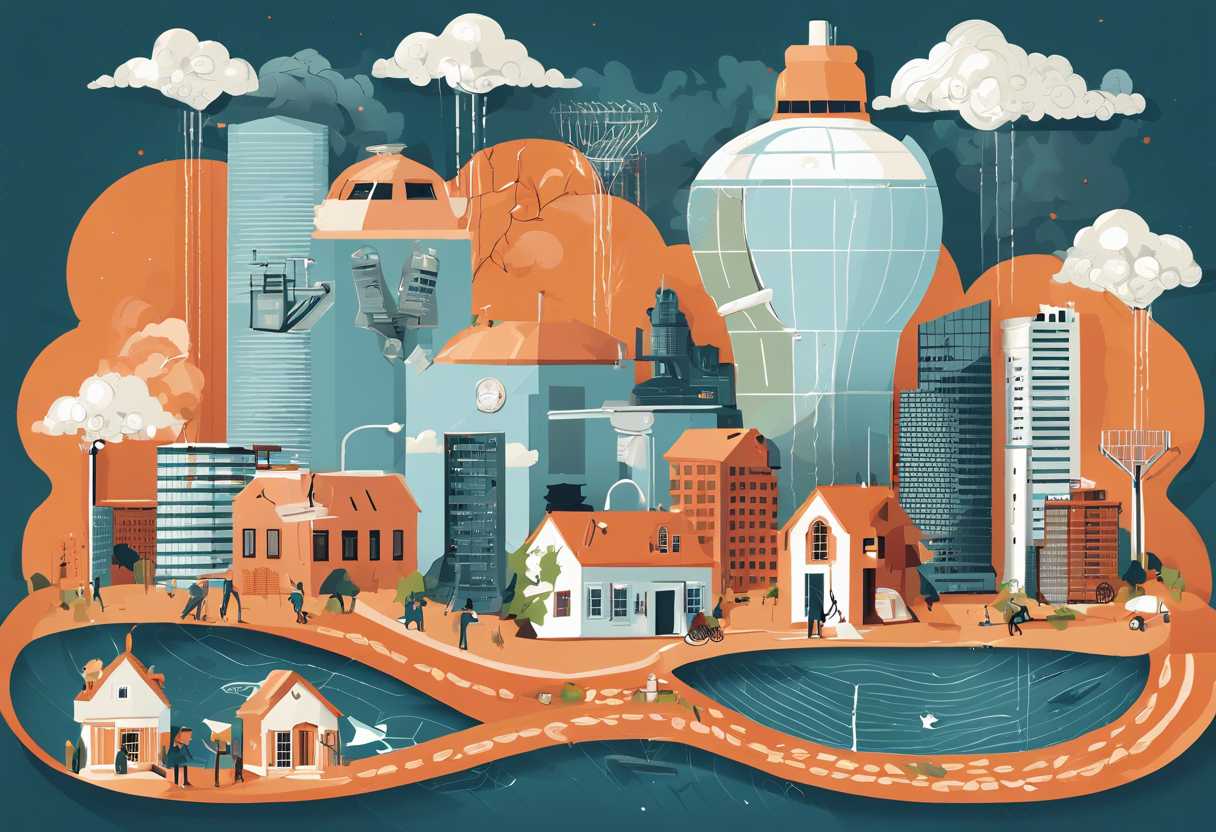Disaster Risk Management is a critical aspect of today’s world, as the frequency and severity of natural and man-made disasters continue to pose significant threats to communities and economies. In this blog post, we will delve into the key principles and strategies for effective Disaster Risk Management, the role of technology and innovation in enhancing disaster preparedness, and the importance of community engagement in building resilience. Additionally, we will explore the future trends and challenges in Disaster Risk Management, shedding light on the evolving landscape of this crucial field. Join us as we uncover the importance of Disaster Risk Management and the strategies to mitigate its impact in our ever-changing world.
Understanding the Importance of Disaster Risk Management in Today’s World
The Growing Need for Disaster Risk Management
With the increasing frequency and severity of natural disasters, the importance of disaster risk management has never been more evident. Climate change, urbanization, and population growth have all contributed to the heightened vulnerability of communities around the world. It is crucial for governments, organizations, and individuals to understand the significance of disaster risk management in order to mitigate the impact of these events.
Key Components of Effective Disaster Risk Management
Disaster risk management involves a range of activities aimed at reducing the impact of disasters on communities and the environment. This includes risk assessment, early warning systems, preparedness and response planning, and recovery and reconstruction efforts. By identifying and addressing vulnerabilities, communities can better prepare for and respond to disasters, ultimately saving lives and minimizing damage.
- Risk assessment
- Early warning systems
- Preparedness and response planning
- Recovery and reconstruction efforts
The Role of Technology in Disaster Risk Management
Advancements in technology have revolutionized the way disaster risk management is approached. Geographic Information Systems (GIS), remote sensing, and predictive modeling have all played a crucial role in identifying high-risk areas and developing targeted strategies for disaster preparedness and response. Additionally, social media and mobile applications have proven to be valuable tools for disseminating information and coordinating relief efforts during and after disasters.
| Geographic Information Systems (GIS) | Remote sensing | Predictive modeling |
| Social media | Mobile applications |

Key Principles and Strategies for Effective Disaster Risk Management
Understanding Disaster Risk Management
Disaster risk management (DRM) is a systematic approach to identifying, assessing, and reducing the risks of disasters. It involves a range of measures aimed at preventing, mitigating, and preparing for disasters, as well as responding to and recovering from their impacts. Effective DRM requires a comprehensive understanding of the hazards, vulnerabilities, and capacities of a community or region, as well as the integration of risk reduction into development planning and decision-making processes.
Principles of Effective DRM
There are several key principles that underpin effective disaster risk management. These include proactive and preventive measures, inclusivity and participation of all stakeholders, integration of risk reduction into development processes, and flexibility and adaptability in response and recovery efforts. Additionally, DRM should be evidence-based and context-specific, taking into account the unique characteristics and needs of the community or region in question.
Strategies for Effective DRM
Effective disaster risk management requires the implementation of a range of strategies and measures. These may include land-use planning to minimize exposure to hazards, early warning systems to alert communities to impending disasters, capacity-building to enhance the resilience of individuals and communities, and investment in infrastructure that is resistant to natural hazards. Additionally, effective DRM involves coordinated and collaborative efforts among government agencies, civil society organizations, and the private sector, as well as education and awareness-raising to empower individuals and communities to take action to reduce their risk.

The Role of Technology and Innovation in Enhancing Disaster Risk Management
Early Warning Systems
One of the key ways in which technology and innovation have enhanced disaster risk management is through the development of early warning systems. These systems use a combination of sensors, data analysis, and communication networks to provide timely alerts about impending natural disasters such as hurricanes, earthquakes, and floods. By leveraging advanced technology, these systems can help authorities and individuals take proactive measures to mitigate the impact of disasters, saving lives and reducing damage to property.
Geographic Information Systems (GIS)
GIS technology has revolutionized disaster risk management by providing a powerful tool for mapping and analyzing geographic data related to natural hazards and vulnerabilities. By integrating various layers of information, such as population density, infrastructure, and environmental factors, GIS enables decision-makers to identify high-risk areas, plan evacuation routes, and allocate resources more effectively. This technology has proven invaluable in improving the preparedness and response capabilities of emergency management agencies.
Drones and Remote Sensing
The use of drones and remote sensing technology has significantly enhanced disaster risk management by enabling rapid and comprehensive assessment of disaster-affected areas. Equipped with high-resolution cameras and other sensors, drones can capture detailed imagery of disaster sites, allowing for the identification of critical needs and the assessment of damage. This real-time data is invaluable for coordinating rescue and relief efforts, as well as for informing long-term recovery and reconstruction plans.
Building Resilience: Community Engagement and Disaster Risk Management
The Importance of Community Engagement in Disaster Risk Management
Community engagement plays a crucial role in disaster risk management. When communities are actively involved in identifying and addressing risks, they become more resilient to disasters. By engaging with local residents, organizations, and authorities, it is possible to develop effective disaster risk reduction strategies that are tailored to the specific needs and vulnerabilities of the community. This can include initiatives such as community-based early warning systems, evacuation plans, and training programs to build local capacity for response and recovery.
Effective Strategies for Engaging Communities in Disaster Risk Management
There are several effective strategies for engaging communities in disaster risk management. One approach is to establish community-based organizations or committees that are responsible for coordinating disaster preparedness and response efforts. These groups can work closely with local authorities and organizations to develop and implement risk reduction initiatives. Additionally, conducting regular community meetings, workshops, and training sessions can help raise awareness about disaster risks and build local capacity for response. It is also important to involve marginalized groups and vulnerable populations in these efforts to ensure that their needs are taken into account.
Measuring the Impact of Community Engagement in Disaster Risk Management
Measuring the impact of community engagement in disaster risk management is essential for evaluating the effectiveness of initiatives and identifying areas for improvement. This can be done through various methods, such as conducting surveys and interviews to gather feedback from community members, analyzing data on disaster preparedness and response activities, and monitoring key indicators of resilience, such as the number of lives saved and the extent of damage mitigated. By regularly assessing the impact of community engagement, it is possible to make informed decisions and adjust strategies to better address the needs of the community.
The Future of Disaster Risk Management: Trends and Challenges Ahead
Technology and Innovation in Disaster Risk Management
Advancements in technology have revolutionized the way disaster risk management is approached. From early warning systems to predictive analytics, technology has enabled more accurate forecasting and better preparedness. *Drones* are now being used for rapid damage assessment, while *artificial intelligence* is being employed to analyze vast amounts of data to identify potential risks. The integration of *big data* and *machine learning* has also improved the ability to predict and mitigate the impact of disasters.
Climate Change and Resilience Building
The increasing frequency and intensity of natural disasters due to climate change have highlighted the need for a shift towards resilience building. *Climate-resilient infrastructure* and *ecosystem-based approaches* are gaining traction as effective strategies for reducing disaster risk. Additionally, there is a growing emphasis on *community-based adaptation* and *inclusive planning* to ensure that vulnerable populations are not disproportionately affected by disasters.
Global Collaboration and Policy Frameworks
Disasters do not recognize borders, and as such, there is a growing recognition of the need for global collaboration in disaster risk management. International frameworks such as the *Sendai Framework for Disaster Risk Reduction* and the *Paris Agreement* have set the stage for coordinated action on disaster risk reduction and climate change adaptation. However, challenges remain in translating these frameworks into actionable policies at the national and local levels, as well as in securing the necessary funding for implementation.
Conclusion
Disaster Risk Management is an essential aspect of today’s world, and understanding its importance is crucial for the safety and well-being of communities. By implementing key principles and strategies, such as risk assessment and early warning systems, we can effectively mitigate the impact of disasters and save lives.
Furthermore, the role of technology and innovation cannot be overstated in enhancing Disaster Risk Management. From advanced forecasting tools to communication systems, technology plays a vital role in improving preparedness and response efforts.
Building resilience through community engagement is another critical factor in Disaster Risk Management. By involving local communities in planning and decision-making processes, we can create sustainable solutions that address the specific needs and vulnerabilities of each area.
As we look to the future, it’s important to stay informed about the latest trends and challenges in Disaster Risk Management. Climate change, urbanization, and other factors continue to shape the landscape of disaster risk, and staying ahead of these trends is essential for effective planning and response.
In conclusion, Disaster Risk Management is a complex and evolving field that requires ongoing attention and dedication. By staying informed, engaging with communities, and leveraging technology, we can work towards a safer and more resilient future for all. Let’s continue to prioritize Disaster Risk Management in our planning and decision-making processes, and together, we can build a more secure world for generations to come.

